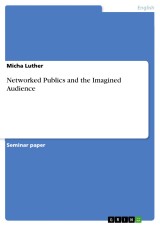Details

Networked Publics and the Imagined Audience
1. Auflage
|
13,99 € |
|
| Verlag: | Grin Verlag |
| Format: | |
| Veröffentl.: | 31.10.2014 |
| ISBN/EAN: | 9783656827832 |
| Sprache: | englisch |
| Anzahl Seiten: | 20 |
Dieses eBook erhalten Sie ohne Kopierschutz.
Beschreibungen
Seminar paper from the year 2014 in the subject English Language and Literature Studies - Other, grade: 2,0, , language: English, abstract: Online platforms like social networks and blogs provide a space for people to share their thoughts and socialize with other people online. We can access content others created and on the other hand present our own content to others. However, the structure of these online environments is not always the same and neither is the audience that can access the content we created. The term “networked publics” is used by danah boyd in her essay Social Network Sites as Networked Publics: Affordances, Dynamics and Implications (2010) to describe these online environments with all of their characteristics. Boyd argues that the term ‘public’ itself is a very vague term describing different things in different contexts. The most important aspects of a ‘networked public’ are on the one hand the space and on the other hand the collective of people that are present on these online networks. However, it is an indisputable fact that online publics or networked publics respectively strongly deviate from what we know as ‘public’ from our traditional environment.
An important difference is the invisibility of our audience online. When we share our thoughts with a certain audience in a conventional (offline) environment we are normally more or less aware of whom we are talking to or writing to. In online net-works on the contrary, the audience remains rather opaque, in most cases we cannot know who will be reading the content that we provide to a public or semi-public environment online. We can only think of what our audience might be like. This is what frequently is referred to as the ‘imagined audience’, because we can only imagine the audience that we are talking to. Thus, we can consider the imagined audience as an integral element of networked publics. The fact that we do not really know our audi-ence sometimes poses problems, because we normally adapt content and style of what we want to share with the potential audience. When we do not know our audience, we sometimes do not know how to behave in an online public e.g. we do not know what language to use. One kind of language might be appropriate to one audience but inappropriate to another one. That is why I also want to point out possible effects of networked publics and imagined audiences on language use, e.g. how does language use differ depending on different imagined audiences?
An important difference is the invisibility of our audience online. When we share our thoughts with a certain audience in a conventional (offline) environment we are normally more or less aware of whom we are talking to or writing to. In online net-works on the contrary, the audience remains rather opaque, in most cases we cannot know who will be reading the content that we provide to a public or semi-public environment online. We can only think of what our audience might be like. This is what frequently is referred to as the ‘imagined audience’, because we can only imagine the audience that we are talking to. Thus, we can consider the imagined audience as an integral element of networked publics. The fact that we do not really know our audi-ence sometimes poses problems, because we normally adapt content and style of what we want to share with the potential audience. When we do not know our audience, we sometimes do not know how to behave in an online public e.g. we do not know what language to use. One kind of language might be appropriate to one audience but inappropriate to another one. That is why I also want to point out possible effects of networked publics and imagined audiences on language use, e.g. how does language use differ depending on different imagined audiences?
Diese Produkte könnten Sie auch interessieren:

Politeness in Shakespeare: Applying Brown and Levinson´s politeness theory to Shakespeare's comedies

von: Abdelaziz Bouchara

43,00 €















